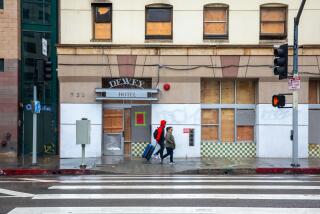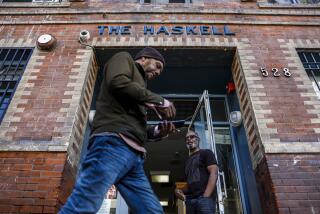Drugs: The ‘root cause’ of homelessness?
Policing skid row remains one of the most controversial topics in Los Angeles, with the White House’s homeless czar joining with the American Civil Liberties Union in arguing that L.A. can’t arrest its way out of the homelessness problem, while beleaguered law enforcement looks for ever-more creative measures to bar former criminals from even showing up in the area.
To argue the enforcement side of the coin, several members of the City Attorney’s office, Chief Deputy City Attorney Rich Llewellyn and Deputy City Attorney Jose Egurbide, came by the editorial board last week to discuss the lawlessness that had been going hand-in-hand with homelessness until they started cracking down last year. Some highlights:
Rich Llewellyn: We just wanted to sort of give you a sense of what we’ve been doing on skid row, and kind of where we see that going, and hopefully to keep y’all engaged because we think this is an opportunity for our local institutions to kind of stay engaged, because we think there are certain opportunities the next few years there. [...]
Just [to] let you know what the City Attorney’s office is doing on skid row, because, um, I think what has gotten most of the coverage, almost exclusive coverage in the press, has been the plight of the homeless in the skid row area in central City. And we just want to let you know that the Safer Cities Initiative is a much broader and more comprehensive initiative that addressed -- that really was intended to, and continues to look at -- the entire community, and the situation of the skid row community, and all the different elements of the population there and all the different problems. [...]
We just think it’s important to understand the full extent of the problems that existed there, because I think a lot of that has been sort of under the radar by everybody, and we being down there on the streets, have really gotten a feel for it. [...] We put together a team of I think terrific prosecutors working very closely with LAPD and a whole variety of partners that really span the spectrum, from LAPD and the sheriff’s and district attorney’s office, to public counsel, ACLU, even LACAN -- I think we’re about the only ones on the city side that work with them in connection with the so-called 28-day shuffle.
So let me give you a few items that we brought down that you might find interesting. First is, I don’t know if you guys have seen this -- I actually spotted it just the night before last -- looks like 18 th Street, which you guys are well aware of, major gang, tagged St. Vibiana’s, so here’s some photos that we took. I think that’s just indicative of the fact that there are some serious criminal problems that remain in that area. [...]
And the last thing is, because there’s one issue that’s sort of come up quite a bit, with Professor Blasi’s report and some of the editorials, is the buy-bust efforts of LAPD, their narcotics unit. This is a nuisance abatement action that we filed -- we call it a narco abatement action -- against two locations on skid row, filed probably about a year ago or so. But the only good thing -- the thing I think is most useful about it is, it sort of goes through and shows how these buy-bust operations work, and so there’s just no misunderstanding that the way they target location--
Tim Cavanaugh: Sorry, let me just get the phrasing: buy-bust?
Llewellyn: Buy-bust, which is essentially a undercover officer negotiating a purchase of a controlled substance down on skid row. It’s usually going to be crack, or crack cocaine, or heroin. And just how it works: they’re not free-roaming sort of just going around the street trying to pick off people. They target locations, particular locations -- it could be a street corner. Now, as we see the change in the way the drug dealers are operating, it’s now more indoors, so it could be in this case a restaurant or a bar, it could be a liquor store. But they target these locations, oftentimes with videotape cameras set up [...] in order to record the transactions, and then they make the busts as part of a comprehensive effort to try to eradicate the drug-dealing problem at that particular location.
And it is a problem in terms of the fact that a lot of drug dealers, probably the vast majority down on skid row, are going to be addicts, and oftentimes homeless. So they will get arrested as part of these operations, but that is because they actually are, they are actually selling, it’s not -- and we have some statistics at the end of the summary we gave you [...] as to the actual, the number of arrests, felony arrests for actual sales, and you’ll see most of the narcotics arrests are for actual sales, not possession with intent to sell, and not necessarily with a just a simple possession.
Cavanaugh: So, can an officer initiate the purchase?
Llewellyn: It can be in all different ways, it can ... it could be an officer approaching somebody, it could be an officer just sort of planting himself and waiting to be approached, it could be an officer approaching an intermediary who’s then, who then passes him on to a seller, or as you’ll see in a lot of these instances he’ll approach somebody, they’ll go into the bar or the restaurant, purchase the narcotic, and then come out with the narcotics; it’s oftentimes wrapped in plastic, they keep it in their mouth in order to conceal it until the actual purchase. Cash changes hands and then they spit it out and hand it over to the narcotics officer. So that’s, you know, the typical scenario down there, and as you can see there’s a tremendous number of arrests, almost 10,000 down there, most narcotics-related, and that’s because as we discovered, as did LAPD, that the narcotics problem was so entrenched and was so serious down there, and that really created or turned out to be the root cause of a lot of the other problems.
Jim Newton: Can I just ask you here, just looking at these numbers, close to 10,000 total arrests, but I only see 2,800 narcotics arrests under felonies for drugs, and 833 for misdemeanors for drugs, so I only see 3,600 out of 9,900 narcotics arrests. Am I reading this incorrectly?
Jose Egurbide: That’s right.
Newton: Oh; so the tremendous majority are not narcotics then? The tremendous majority--
Egurbide: About 44% of the felonies, are, of the felony arrests are--
Llewellyn: Narcotics-related.
Egurbide: Narcotics-related.
Newton: And about--
Egurbide: About a half.
Newton: And then a significantly smaller percentage of the misdemeanor arrests?
Egurbide: Yes.
Newton: I see. OK. So what are the balance for? What are the other, I mean what are the majority of these arrests for if not narcotics?
Egurbide: Uhh, it’s a wide, I mean, it’s a wide variety--
Newton: Just a whole--
Egurbide: On the felony-- and as you’ll see in the conclusions our efforts have been, you know, across the board, I mean robberies, GTAs, burglaries--
Newton: Got it.
Llewellyn: Assaults.
Newton: OK. OK.
Llewellyn: And as we indicate in our first-year goals, I mean, the big thing was to try to reduce crime overall, because it was rampant at the time at the outset of the initiative. But one thing I think that gets overlooked sometimes is not just reducing crime overall but also reducing the serious crime, and I think that’s indicated that we have been successful at least towards our first-year goals by the fact that we’ve seen the reduction in our ratio between felony arrests and prosecutions and misdemeanor arrests and prosecutions.
And that’s a big indicator for us; it’s somewhat difficult, to, you know, for the public to absorb, but the fact is that when we started off we were looking at two-thirds felony to one-third misdemeanor ratio, which is incredibly high. I mean you’re talking about even if you try to discount for the fact that now you had increased police presence, D.A. change in policy, etc., it’s still just tremendously high. Now we’re about a one-to-one ratio in felonies to misdemeanors. By the end of this year we hope that we’re at a one-third felony to two-third misdemeanor ratio, and then move from there.
But that really shows I think what was going on in terms of statistically, what was going on in that area, and the seriousness of the problems and the seriousness in the crime.






